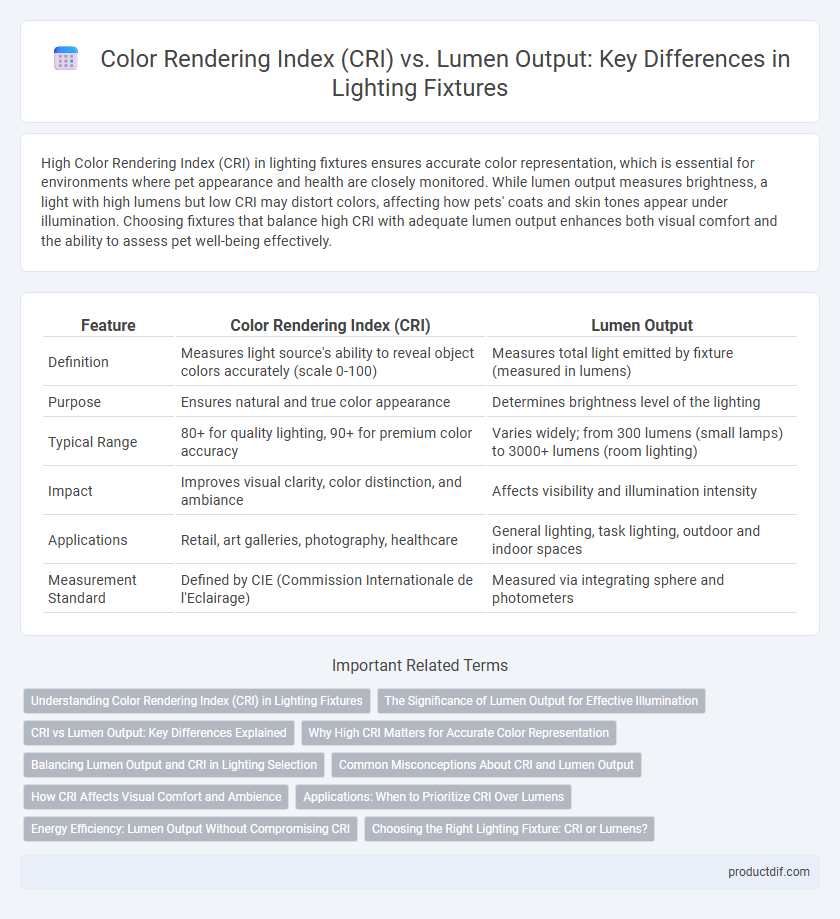High Color Rendering Index (CRI) in lighting fixtures ensures accurate color representation, which is essential for environments where pet appearance and health are closely monitored. While lumen output measures brightness, a light with high lumens but low CRI may distort colors, affecting how pets' coats and skin tones appear under illumination. Choosing fixtures that balance high CRI with adequate lumen output enhances both visual comfort and the ability to assess pet well-being effectively.
Table of Comparison
| Feature | Color Rendering Index (CRI) | Lumen Output |
|---|---|---|
| Definition | Measures light source's ability to reveal object colors accurately (scale 0-100) | Measures total light emitted by fixture (measured in lumens) |
| Purpose | Ensures natural and true color appearance | Determines brightness level of the lighting |
| Typical Range | 80+ for quality lighting, 90+ for premium color accuracy | Varies widely; from 300 lumens (small lamps) to 3000+ lumens (room lighting) |
| Impact | Improves visual clarity, color distinction, and ambiance | Affects visibility and illumination intensity |
| Applications | Retail, art galleries, photography, healthcare | General lighting, task lighting, outdoor and indoor spaces |
| Measurement Standard | Defined by CIE (Commission Internationale de l'Eclairage) | Measured via integrating sphere and photometers |
Understanding Color Rendering Index (CRI) in Lighting Fixtures
Color Rendering Index (CRI) in lighting fixtures measures how accurately a light source reveals the colors of objects compared to natural light, with a scale from 0 to 100. A higher CRI value, typically above 80, ensures true color representation, essential for tasks requiring color accuracy such as retail displays and art studios. While lumen output indicates brightness, CRI focuses on color quality, making both metrics crucial for selecting optimal lighting solutions.
The Significance of Lumen Output for Effective Illumination
Lumen output measures the total amount of visible light emitted by a lighting fixture, crucial for achieving effective illumination in a space. While Color Rendering Index (CRI) assesses how accurately colors appear under the light, lumen output directly influences the brightness and coverage area. High lumen output ensures sufficient light levels, enhancing visibility and functionality in residential, commercial, and industrial environments.
CRI vs Lumen Output: Key Differences Explained
Color Rendering Index (CRI) measures a lighting fixture's ability to reveal colors accurately compared to natural light, while lumen output quantifies the total visible light emitted. High CRI values, typically above 80, ensure vibrant and true-to-life colors, crucial for applications like retail and art galleries. Conversely, lumen output, measured in lumens, indicates brightness level but does not reflect color quality, making both metrics essential for balanced lighting design.
Why High CRI Matters for Accurate Color Representation
High Color Rendering Index (CRI) is crucial for accurate color representation, ensuring that illuminated objects reveal their true colors under artificial lighting, which standard lumen output alone cannot guarantee. While lumens measure brightness, a high CRI light source enhances visual clarity by rendering colors more naturally and vividly, important in settings like retail, art galleries, and medical facilities. Lighting fixtures with CRI values above 90 are preferred to maintain color fidelity and improve overall visual experience.
Balancing Lumen Output and CRI in Lighting Selection
Balancing lumen output and Color Rendering Index (CRI) is essential for optimizing lighting fixture performance, ensuring both brightness and accurate color representation. Fixtures with high lumen output but low CRI may provide sufficient light but distort colors, while those with high CRI and lower lumens offer vivid, natural color visibility ideal for task-oriented environments. Selecting lighting solutions requires evaluating CRI values above 80 for quality color accuracy alongside lumen levels that meet spatial illumination needs without compromising energy efficiency.
Common Misconceptions About CRI and Lumen Output
Color Rendering Index (CRI) measures a light source's ability to accurately reproduce colors compared to natural light, while lumen output quantifies the total light emitted. A high lumen output does not guarantee accurate color rendering; low CRI lights can appear bright but distort colors significantly. Many mistakenly equate brightness with color quality, overlooking that effective lighting design requires balancing both high CRI and adequate lumens for optimal visual experience.
How CRI Affects Visual Comfort and Ambience
A high Color Rendering Index (CRI) in lighting fixtures enhances visual comfort by accurately revealing colors, which reduces eye strain and improves mood. While lumen output measures brightness, CRI determines the quality of light and how naturally colors appear under illumination. Selecting a lighting fixture with a CRI above 80 ensures vibrant, true-to-life color rendering that positively influences ambience and user experience.
Applications: When to Prioritize CRI Over Lumens
High Color Rendering Index (CRI) is essential in applications such as art galleries, retail stores, and medical facilities where accurate color representation affects visual perception and decision-making. Lumen output is prioritized in general illumination settings like warehouses or street lighting where brightness is the main concern. Selecting lighting fixtures with a CRI above 80 ensures true color accuracy, crucial for tasks involving color matching or fine detail observation.
Energy Efficiency: Lumen Output Without Compromising CRI
High-quality lighting fixtures balance lumen output and Color Rendering Index (CRI) to enhance energy efficiency without sacrificing color accuracy. Fixtures with high CRI values (above 80) ensure true color representation, crucial for environments requiring precise color discrimination, while optimized lumen output reduces energy consumption. Advanced LED technology achieves bright illumination paired with superior CRI, maximizing lumen efficiency per watt and minimizing electricity costs.
Choosing the Right Lighting Fixture: CRI or Lumens?
Selecting the right lighting fixture involves balancing Color Rendering Index (CRI) and lumen output to meet specific needs; high CRI values above 80 ensure accurate color representation, essential for tasks requiring color precision, while lumens measure brightness, with higher lumens suitable for illuminating larger spaces. Fixtures with a CRI of 90 or above provide vibrant, true-to-life colors, ideal for retail, art studios, and medical environments. Prioritizing CRI ensures visual clarity and color accuracy, whereas focusing on lumens guarantees sufficient illumination intensity.
Color Rendering Index (CRI) vs Lumen Output Infographic

 productdif.com
productdif.com